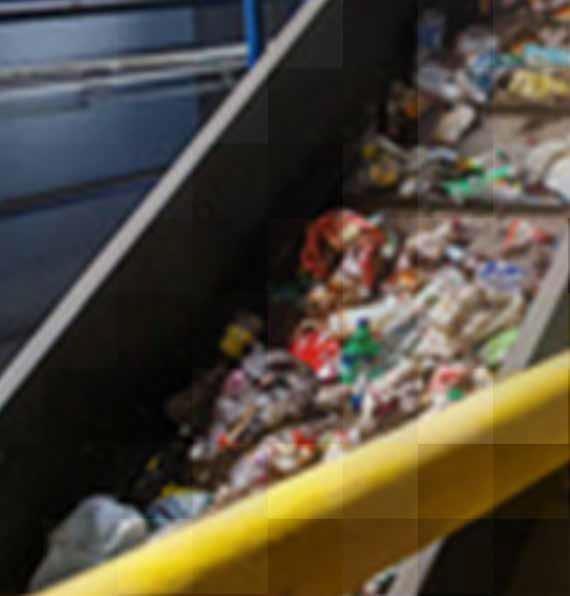The main point of the agreement was to include exporting and importing of plastic waste in the scope of the regulations. It drew a great deal of attention because the responsibility of developed countries, which relied on third countries in the treatment of plastic waste, was made clear.
Reduction of plastic waste is a pressing issue for the entire human race. Hamamatsu infrared image sensors will contribute at the forefront to tackle this issue.
Hyperspectral imaging that improves the “screening accuracy” of plastic
When the waste amount of container packaging per person is compared, Japan produces the second largest plastic waste in the world. In addition to China (the last year’s largest undertaker) banned the reception of plastic waste, the enactment of a regulation on exporting recycle resources to developing countries has increased the importance of recycling plastic waste.
The key to effective plastic recycling is the identification of materials. Currently, a lot of the plastic waste is cut into little pieces with a shredder and then separated by materials. The screening method in this process that is receiving a lot of attention recently is “hyperspectral imaging,” which distinguishes differences in plastic using infrared light. Hyperspectral imaging is a method by which pixel-level spectrum information is acquired simultaneously with the shooting of the target object. It is a useful method to identify and classify materials that are difficult to distinguish by eyesight. A hyperspectral camera is used to acquire hyperspectral images. Like normal line cameras, scanning is performed by moving the target object (or camera). The input light passes through a slit, is dispersed into the Y-axis direction by a prism/grating, and is measured by an area image sensor. Because a spectrum that has special characteristics can be obtained in the infrared wavelength range depending on the plastic material, using a hyperspectral camera with a built-in infrared area image sensor allows highly accurate identification.
Infrared light detectable up to 2.55 μm
Correspond identification of plastic that includes flame-retardant resin
Hamamatsu has so far been producing InGaAs area image sensors that can detect infrared light up to 1.7 μm, but in this spectral range, identification of plastic that includes flame-retardant resin was difficult. As such, there were demands for sensors that could detect wavelengths up to about 2.4 μm, which exhibit differences in spectrum waveforms depending on the presence/absence of flame-retarded resin. To meet these market demands, Hamamatsu developed and released the G14674-0808W featuring a cutoff wavelength of 2.55 μm, which is the world’s longest in InGaAs area image sensors. In addition to making the InGaAs photodiode capable of handling longer wavelengths, the readout circuit was also improved to achieve lower dark current and higher speed. The integration of this product into a hyperspectral camera expands the range of recyclable materials that can be screened and encourages recycling rate improvement.
Main features
Cutoff wavelength: 2.55 μm
Hamamatsu has successfully reduced the amount of defects that occur in the photosensitive area by optimizing the composition ratio of InAs and GaAs in the InGaAs photosensitive area and improving the process used to produce the photosensitive area. As a result, we were able to realize InGaAs area image sensors that can detect infrared light up to 2.55 μm. The product lineup also includes 1.69 / 1.85 / 2.15 μm cutoff wavelength types.
High-speed readout
Narrower transistor gate length was achieved by designing and manufacturing original optimized circuits (ROIC*) in Hamamatsu. We were able to shorten the electrical signal transmission path. As a result, a frame rate of 507 fps max., which is more than double that of the current product, was achieved.
Low dark current
An improved circuit that brings the voltage difference applied across the anode and cathode of the photosensitive area closer to zero was adopted to reduce the dark current that occurs in the photosensitive area.
Applications expected with the capability of handling longer wavelengths
Hyperspectral imaging is used in food, pharmaceutical, chemical, and other various fields not just in the identification of plastic. The possibility is limitless. With the development of image sensors capable of handling longer wavelengths, there is growing expectations for this technique to be used in applications such as the degradation diagnosis of concrete structures and identification of tablets, which were difficult in the past. Hamamatsu will continue to pursue the development of long-wavelength detection and develop products that meet customer needs.
Hamamatsu Photonics Deutschland GmbH
Arzberger Str. 10
82211 Herrsching am Ammersee
Telefon: +49 (8152) 375-0
Telefax: +49 (8152) 375-199
http://www.hamamatsu.com
Public Relations
Telefon: +49 (8152) 375-185
Fax: +49 (8152) 375-199
E-Mail: rfritsch@hamamatsu.de
![]()
